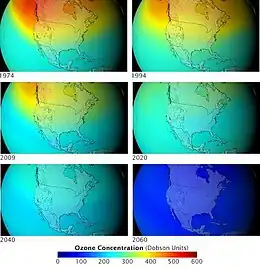Chlorofluorocarbon
A chlorofluorocarbon (CFC) is a gas used for various purposes including solvents, refrigerants, and aerosol sprays. They are organic chemicals and contain carbon, hydrogen, chlorine, and fluorine. They were much used in the middle of the 20th century, replacing chemicals that were toxic or flammable or had other problems.

NASA projection of stratospheric ozone, in Dobson units, if chlorofluorocarbons had not been banned.
In 1978, Sweden became the first country that banned CFC products. Later, the US and Canada did the same. Now, CFC products are not allowed in most countries, because they cause ozone depletion. CFCs are greenhouse gases. An alternative to chlorofluorocarbons is hydrofluorocarbons (HFCs). These do not destroy the ozone layer or increase global warming.[1][2]
Related pages
- Thomas Midgley (American inventor)
- Freon
References
- John M. Broder (November 9, 2010). "A novel tactic in climate fight". The New York Times. p. A9. Retrieved 2013-02-05.
- M. Rossberg et al. Chlorinated hydrocarbons in Ullmann's Encyclopedia of Industrial Chemistry 2006, Wiley-VCH, Weinheim. doi:10.1002/14356007.a06_233.pub2

Ozone-depleting gas trends
This article is issued from Wikipedia. The text is licensed under Creative Commons - Attribution - Sharealike. Additional terms may apply for the media files.
.jpg.webp)